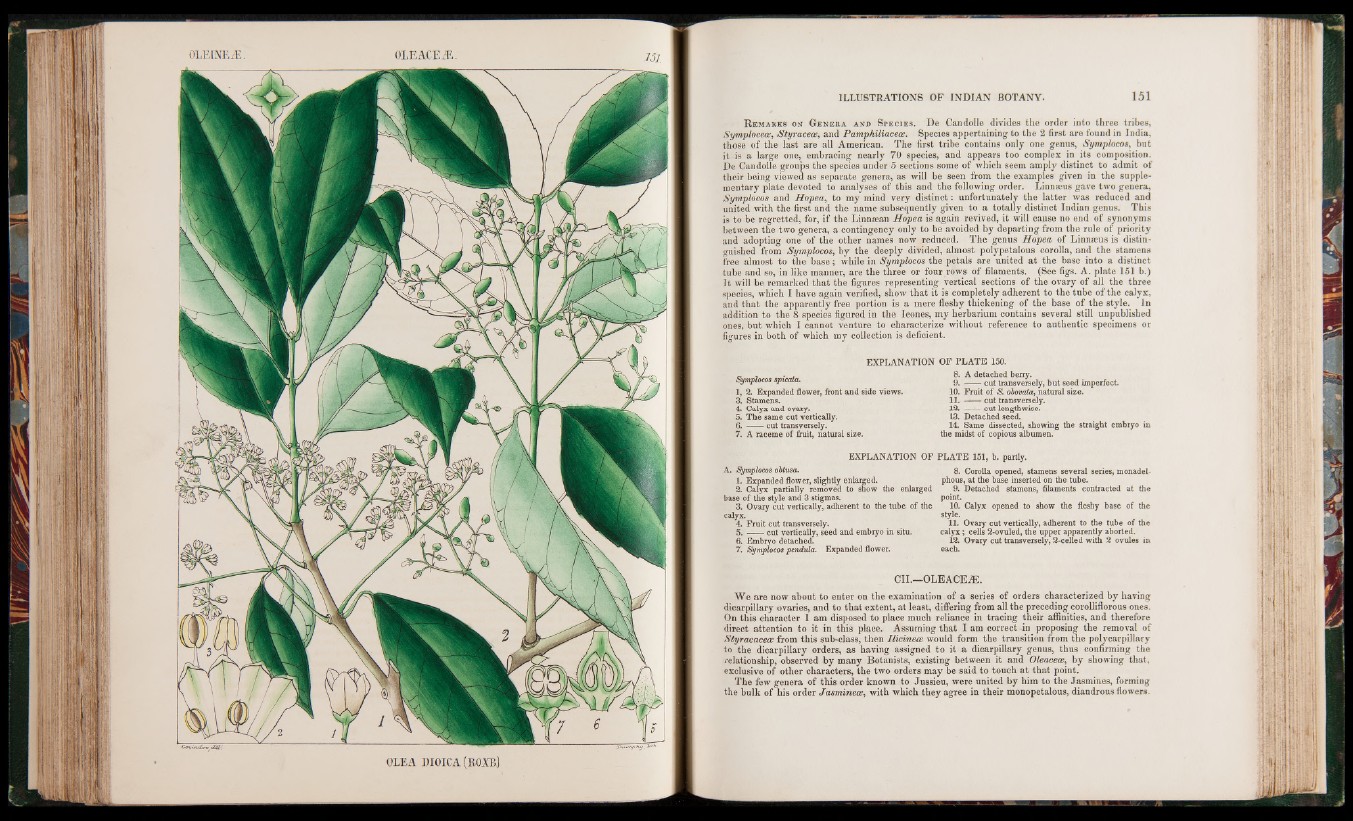
OLEINËÆ OLEACEÆ
OIEA DIOICA (ROXBj
R emarks on Genera and Species. De Candolle divides the order into three tribes,
Symplocece, Styracece, and Pamphiliacece. Species appertaining to the 2 first are found in India,
those of the last are all American. The first tribe contains only one genus, Symplocos, but
it is a large one, embracing nearly 70 species, and appears too complex in its composition.
De Candolle groups the species under 5 sections some of which seem amply distinct to admit of
their being viewed as separate genera, as will be seen from the examples given in the supplementary
plate devoted to analyses of this and the following order. Linnaeus gave two genera,
Symplocos and Hopea, to my mind very distinct: unfortunately the latter was reduced and
united with the first and the name subsequently given to a totally distinct Indian genus. This
is to be regretted, for, if the Linnaean Hopea is again revived, it will cause no end of synonyms
between the two genera, a contingency only to be avoided by departing from the rule of priority
and adopting one of the other names now reduced. The genus Hopea of Linnaeus is distinguished
from Symplocos, by the deeply divided, almost polypetalous corolla, and the stamens
free almost to the base; while in Symplocos the petals are united at the base into a distinct
tube and so, in like manner, are the three or four rows of filaments, (See figs. A. plate 151 b.)
It will be remarked that the figures representing vertical sections of the ovary of all the three
species, which I have again verified, show that it is completely adherent to the tube of the calyx,
and that the apparently free portion is a mere fleshy thickening of the base of the style. In
addition to the 8 species figured in the leones, my herbarium contains several still unpublished
ones, but which I cannot venture to characterize without reference to authentic specimens or
figures in both of which my collection is deficient.
EXPLANATION OP PLATE 150.
Symplocos spicata.
1, 2. Expanded flower, front and side views.
3. Stamens.
4. Calyx and ovary.
5. The same cut vertically.
6 . --------------------- cut transversely.
7. A raceme of fruit, natural size.
8. A detached berry.
9. —— cut transversely, but seed imperfect.
10. Fruit of & obovata, natural size.
1 1 . ------ cut transversely.
1 2 . ------ cut lengthwise.
13. Detached seed.
14. Same dissected, showing the straight embryo in
the midst of copious albumen.
EXPLANATION OP PLATE 151, b. partly.
A. Symplocos obtusa.
1. Expanded flower, slightly enlarged.
2. Calyx partially removed to snow the enlarged
base of the style and 3 stigmas.
3. Ovary cut vertically, adherent to the tube of the
calyx.
4. Fruit cut transversely.
5 . ----cut vertically, seed and embryo in situ.
6. Embryo detached.
7. Symplocos pcndula. Expanded flower.
8. Corolla opened, stamens several series, monadel-
phous, at the base inserted on the tube.
9. Detached stamens, filaments contracted at the
point.
10. Calyx opened to show the fleshy base o f the
style.
11. Ovary cut vertically, adherent to the tube of the
calyx; cells 2-ovuled, the upper apparently aborted.
12. Ovary cut transversely, 2-celled with 2 ovules in
each.
CII.—OLEACEiE.
We are now about to enter on the examination of a series of orders characterized by having
dicarpillary ovaries, and to that extent, at least, differing from all the preceding corolliflorous ones.
On this character I am disposed to place much reliance in tracing their affinities, and therefore
direct attention to it in this place. Assuming that I am correct -in proposing the removal of
Styracacece from this sub-class, then Ilicinece would form the transition from the polycarpillary
to the dicarpillary orders, as having assigned to it a dicarpillary genus, thus confirming the
relationship, observed by many Botanists, existing between it and Oleacece, by showing that,
exclusive of other characters, the two orders may be said to touch at that point.
The few genera of this order known to Jussieu, were united by him to the Jasmines, forming
the bulk of his order Jasminece, with which they agree in their monopetalous, diandrous flowers.